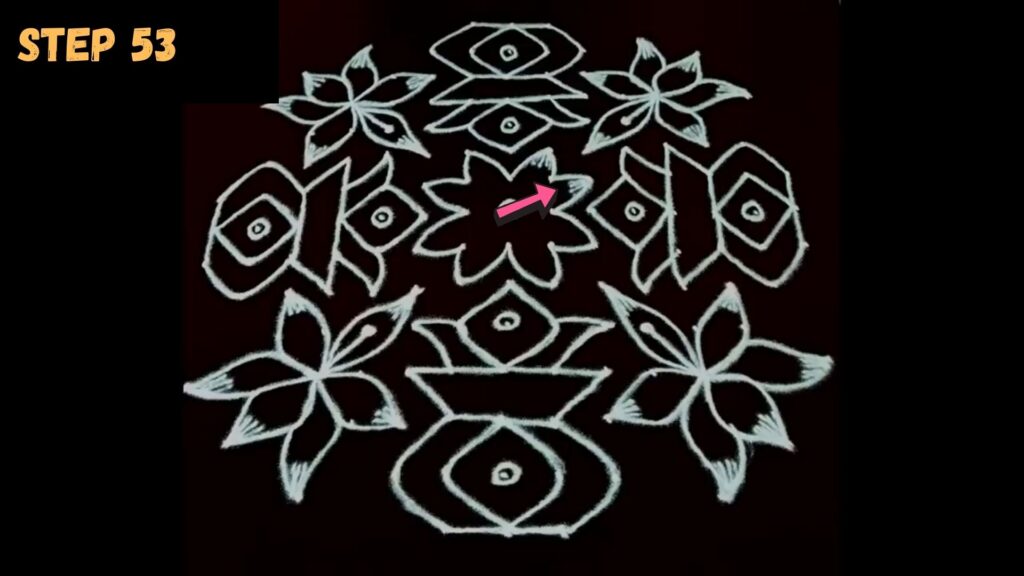Name of Rangoli Design: Pongal Rangoli Designs with Dots | Pongal Kolam
Surface to Draw Rangoli: Front door entrance, sidewalks of the main door entrance, corners of the house

Materials Required: To make the outline of the Pongal Kolam, you can use rice flour, chalk powder, or white rangoli powder. Using white colour for outlining the Pongal Kolam is considered sacred because white signifies purity, innocence, peace, and simplicity. Make your Kolam freehand by taking the rangoli material between your thumb and forefingers and letting it flow freehand. If you are not comfortable freehand, use a mehndi cone or a tube.
Steps 1 to 8: Pongal Rangoli Designs with Dots Design #14
The first 8 steps are about creating a 15-3 dot grid used for Pongal rangoli. See the images for steps 1 to 8 and create 15×3 grid on the surface where you want to create your rangoli design.









Steps 9 to 29: Pongal Rangoli Designs with Dots Design #14
Check the image for step 9 and that is exactly how your 15-3 rangoli dots grid should look like. From step 10 onwards we will start making the design by connecting the dots as shown in Steps 9 to 26. At step 26 of the Pongal rangoli Kolam, we have one Pongal pot ready. We will repeat steps 9 to 26 three more times so that we have the Pongal pots on each side of our rangoli surface as shown in step 29.





















Steps 30 to 43: Pongal Kolam Design
In steps 30 to 43 of Pongal Kolam designing with dots, we will start drawing the lotus-like flowers between each adjoining Pongal pots. Follow the red marker shown in steps 30 to 43 in order to do so.














Steps 44 to 59: Pongal Kolam Design
You are at the final stages of designing the Pongal Kolam. Here we will work at the centre of the Pongal Kolam and create an 8-petal flower. On reaching step 59 of the rangoli design, your Pongal Kolam is ready.
















Final Pongal Rangoli Design
You did a great job and your final Pongal Rangoli Design is ready. You can decorate it with various colours or any other colourful material that you want to.

Hope you enjoyed the Pongal Rangoli Design with Dots or Pongal Kolam. Keep visiting our website for many more rangoli designs with dots.
Facts about Pongal
Pongal is a festival that has great antiquity. It dates back to at least 1000 years, as evidenced by epigraphical evidence in the Puthiyeedu from the Medieval Chola Empire days. Puthiyeedu is the first harvest of the year.
Cash crops such as rice, sugarcane and turmeric are often harvested in the month Thai (January-February). Pongal festival is associated to the annual harvest season.
‘Pongal’ is a Tamil term that means “to boil,” and it’s symbolic of our happiness, as well as the fact that our agricultural produce is ”overflowing to the brim.’ This festival is a way to express gratitude to the Sun God, who is a perineal source light and energy. It is celebrated by people of all faiths. It is especially popular in rural areas where the farmers get a reward called Pongal Enam, which includes cash, clothes, and other items, from the large land owners.
This festival is known as Makara Sankaranthi in other states, Bihu in Assam and Bihar, Uttarayana in Rajasthan and Gujarat, and Maghi (Lohri) in Punjab or Haryana.
Pongal is the name for a dish that is eaten during Pongal. It is sweetened rice cooked with lentils, jaggery, country sugar, grated coconut and other ingredients. Offerings of flowers and gifts are accepted during the auspicious days in Tamil Nadu. Pongal Prasadam is a very common practice and has been around for centuries. It is prepared in the temple’s kitchen, called MadappalliIn. All the cooks are from the Brahmin community. This tradition is also followed in India by Puri Jagannath Temple of Odhisa and Viswanath Temple, Varanasi (UP).







